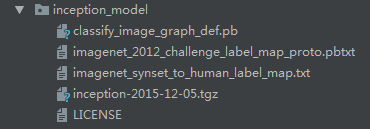机器学习与Tensorflow(7)——tf.train.Saver()、inception-v3的应用
1. tf.train.Saver()
- tf.train.Saver()是一个类,提供了变量、模型(也称图Graph)的保存和恢复模型方法。
- TensorFlow是通过构造Graph的方式进行深度学习,任何操作(如卷积、池化等)都需要operator,保存和恢复操作也不例外。
- 在tf.train.Saver()类初始化时,用于保存和恢复的save和restore operator会被加入Graph。所以,下列类初始化操作应在搭建Graph时完成。
saver = tf.train.Saver()
TensorFlow的保存和恢复分为两种:
- 保存和恢复变量
- 保存和恢复模型
saver.save()保存模型
#举例:
保存一个训练好的手写数据集识别模型
保存在当前路径的net文件夹中
import os
os.environ['TF_CPP_MIN_LOG_LEVEL'] = ''
import tensorflow as tf
from tensorflow.examples.tutorials.mnist import input_data #载入数据集
mnist = input_data.read_data_sets('MNIST_data', one_hot=True) #每个批次100张照片
batch_size = 100
#计算一个需要多少个批次
n_batch = mnist.train.num_examples // batch_size #定义两个placeholder
x = tf.placeholder(tf.float32, [None, 784])
y = tf.placeholder(tf.float32, [None, 10]) #创建一个简单的神经网络,输入层784个神经元,输出层10个神经元
W = tf.Variable(tf.zeros([784, 10]))
b = tf.Variable(tf.zeros([10]))
prediction = tf.nn.softmax(tf.matmul(x, W) + b)
#代价函数
loss = tf.reduce_mean(tf.nn.softmax_cross_entropy_with_logits(labels=y, logits=prediction))
#使用梯度下降法
train_step = tf.train.GradientDescentOptimizer(0.2).minimize(loss) #初始化变量
init = tf.global_variables_initializer() #结果存放在一个布尔型列表中
correct_prediction = tf.equal(tf.argmax(y, 1), tf.argmax(prediction, 1)) accuracy = tf.reduce_mean(tf.cast(correct_prediction, tf.float32)) saver = tf.train.Saver() with tf.Session() as sess:
sess.run(init)
for epoch in range(11):
for batch in range(n_batch):
batch_xs, batch_ys = mnist.train.next_batch(batch_size)
sess.run(train_step, feed_dict={x:batch_xs, y:batch_ys})
acc = sess.run(accuracy, feed_dict={x:mnist.test.images, y:mnist.test.labels})
print('Iter = ' + str(epoch) +', Testing Accuracy = ' + str(acc))
#保存模型
saver.save(sess, 'net/my_net.ckpt')
#保存路径中的文件为:
checkpoint:保存当前网络状态的文件
my_net.ckpt.data-00000-of-00001
my_net.ckpt.index
my_net.ckpt.meta:保存Graph结构的文件

#关于函数saver.save(),常用的参数就是前三个:
save(
sess, # 必需参数,Session对象
save_path, # 必需参数,存储路径
global_step=None, # 可以是Tensor, Tensor name, 整型数
latest_filename=None, # 协议缓冲文件名,默认为'checkpoint',不用管
meta_graph_suffix='meta', # 图文件的后缀,默认为'.meta',不用管
write_meta_graph=True, # 是否保存Graph
write_state=True, # 建议选择默认值True
strip_default_attrs=False # 是否跳过具有默认值的节点
saver.restore()加载已经训练好的模型
#举例:
通过加载刚才保存的训练好的手写数据集识别模型进行手写数据集的识别
import os
os.environ['TF_CPP_MIN_LOG_LEVEL'] = ''
import tensorflow as tf
from tensorflow.examples.tutorials.mnist import input_data mnist = input_data.read_data_sets('MNIST_data', one_hot=True)
batch_size = 100
n_batch = mnist.train.num_examples // batch_size x = tf.placeholder(tf.float32, [None, 784])
y = tf.placeholder(tf.float32, [None, 10]) W = tf.Variable(tf.zeros([784, 10]))
b = tf.Variable(tf.zeros([10]))
prediction = tf.nn.softmax(tf.matmul(x, W) + b) loss = tf.reduce_mean(tf.nn.softmax_cross_entropy_with_logits(labels=y, logits=prediction))
train_step = tf.train.GradientDescentOptimizer(0.2).minimize(loss) init = tf.global_variables_initializer() correct_prediction = tf.equal(tf.argmax(y, 1), tf.argmax(prediction, 1))
accuracy = tf.reduce_mean(tf.cast(correct_prediction, tf.float32)) saver = tf.train.Saver() with tf.Session() as sess:
sess.run(init)
print(sess.run(accuracy, feed_dict={x:mnist.test.images, y:mnist.test.labels}))
saver.restore(sess, 'net/my_net.ckpt')
print(sess.run(accuracy, feed_dict={x:mnist.test.images, y:mnist.test.labels}))
#执行结果: 0.098
0.9178 #直接得到的准确率相当低,通过加载训练好的模型,识别准确率大大提升。
2. 下载google图像识别网络inception-v3并查看结构
模型背景:
Inception(v3) 模型是Google 训练好的最新一个图像识别模型,我们可以利用它来对我们的图像进行识别。
下载地址:
https://storage.googleapis.com/download.tensorflow.org/models/inception_dec_2015.zip
文件描述:
- classify_image_graph_def.pb 文件就是训练好的Inception-v3模型。
- imagenet_synset_to_human_label_map.txt是类别文件,包含人类标签和uid之间的映射的文件。
- imagenet_2012_challenge_label_map_proto.pbtxt是包含类号和uid之间的映射的文件。
代码实现
import os
os.environ['TF_CPP_MIN_LOG_LEVEL'] = ''
import tensorflow as tf
import tarfile
import requests #inception模型下载地址
inception_pretrain_model_url = 'http://download.tensorflow.org/models/image/imagenet/inception-2015-12-05.tgz' #inception模型存放地址
inception_pretrain_model_dir = 'inception_model'
if not os.path.exists(inception_pretrain_model_dir):
os.makedirs(inception_pretrain_model_dir)
#获取文件名,以及文件路径
filename = inception_pretrain_model_url.split('/')[-1]
filepath = os.path.join(inception_pretrain_model_dir, filename) #下载模型
if not os.path.exists(filepath):
print('download: ', filename)
r = requests.get(inception_pretrain_model_url, stream=True)
with open(filepath, 'wb') as f:
for chunk in r.iter_content(chunk_size=1024):
if chunk:
f.write(chunk)
print('finish: ', filename)
#解压文件
tarfile.open(filepath, 'r:gz').extractall(inception_pretrain_model_dir) #模型结构存放文件
log_dir = 'inception_log'
if not os.path.exists(log_dir):
os.makedirs(log_dir) #classify_image_graph_def.pb为google训练好的模型
inception_graph_def_file = os.path.join(inception_pretrain_model_dir, 'classify_image_graph_def.pb')
with tf.Session() as sess:
#创建一个图来存放google训练好的模型
with tf.gfile.FastGFile(inception_graph_def_file, 'rb') as f:
graph_def = tf.GraphDef()
graph_def.ParseFromString(f.read())
tf.import_graph_def(graph_def, name='')
#保存图的结构
writer = tf.summary.FileWriter(log_dir, sess.graph)
writer.close()
#在下载过程中,下的特别慢,不知道是网络原因还是什么
#程序总卡着不动
#所以我就手动下载压缩包并进行解压
下载结果

3. 使用inception-v3做各种图像的识别
#代码实现:
import os
os.environ['TF_CPP_MIN_LOG_LEVEL'] = ''
import tensorflow as tf
import numpy as np
import re
from PIL import Image
import matplotlib.pyplot as plt #这部分是对标签号和类别号文件进行一个预处理 class NodeLookup(object):
def __init__(self):
label_lookup_path = 'inception_model/imagenet_2012_challenge_label_map_proto.pbtxt'
uid_lookup_path = 'inception_model/imagenet_synset_to_human_label_map.txt'
self.node_lookup = self.load(label_lookup_path, uid_lookup_path)
def load(self, label_lookup_path, uid_lookup_path):
#加载分类字符串n********对应分类名称的文件
proto_as_ascii_lines = tf.gfile.GFile(uid_lookup_path).readlines()
uid_to_human={}
#一行一行读取数据
for line in proto_as_ascii_lines:
#去掉换行符
line = line.strip('\n')
#按照‘\t’进行分割
parsed_items = line.split('\t')
#获取分类编号
uid = parsed_items[0]
#获取分类名称
human_string = parsed_items[1]
#保存编号字符串n********与分类名称的映射关系
uid_to_human[uid] = human_string #加载分类字符串n********对应分类编号1-1000的文件
proto_as_ascii = tf.gfile.GFile(label_lookup_path).readlines()
node_id_to_uid = {}
for line in proto_as_ascii:
if line.startswith(' target_class:'):
#获取分类编号1-1000
target_class = int(line.split(': ')[1])
if line.startswith(' target_class_string:'):
#获取编号字符串nn********
target_class_string = line.split(': ')[1]
# 保存分类编号1-1000与编号字符串n********映射关系
node_id_to_uid[target_class] = target_class_string[1:-2]
# 建立分类编号1-1000对应分类名称的映射关系
node_id_to_name = {}
for key, val in node_id_to_uid.items():
#获取分类名称
name = uid_to_human[val]
# 建立分类编号1-1000到分类名称的映射关系
node_id_to_name[key] = name
return node_id_to_name
# 传入分类编号1-1000返回分类名称
def id_to_string(self, node_id):
if node_id not in self.node_lookup:
return ''
return self.node_lookup[node_id] #创建一个图来存放google训练好的模型 with tf.gfile.FastGFile('inception_model/classify_image_graph_def.pb', 'rb') as f:
graph_def = tf.GraphDef()
graph_def.ParseFromString(f.read())
tf.import_graph_def(graph_def, name='') with tf.Session() as sess:
softmax_tensor = sess.graph.get_tensor_by_name('softmax:0')
#遍历目录
for root, dirs, files in os.walk('images/'):
for file in files:
#载入图片
image_data = tf.gfile.FastGFile(os.path.join(root, file), 'rb').read()
predictions = sess.run(softmax_tensor, {'DecodeJpeg/contents:0': image_data})#图片格式是jpg格式
predictions = np.squeeze(predictions)#把结果转为1维数据 #打印图片路径及名称
image_path = os.path.join(root, file)
print(image_path) # 显示图片
img = Image.open(image_path)
plt.imshow(img)
plt.axis('off')
plt.show() #排序
top_k = predictions.argsort()[-5:][::-1]
node_lookup = NodeLookup()
for node_id in top_k:
# 获取分类名称
human_string = node_lookup.id_to_string(node_id)
# 获取该分类的置信度
score = predictions[node_id]
print('%s(score = %.5f)' % (human_string, score))
print()
#执行结果:
images/1.jpg
giant panda, panda, panda bear, coon bear, Ailuropoda melanoleuca(score = 0.87265)
badger(score = 0.00260)
lesser panda, red panda, panda, bear cat, cat bear, Ailurus fulgens(score = 0.00205)
brown bear, bruin, Ursus arctos(score = 0.00102)
ice bear, polar bear, Ursus Maritimus, Thalarctos maritimus(score = 0.00099) images/2.jpg
French bulldog(score = 0.94474)
bull mastiff(score = 0.00559)
pug, pug-dog(score = 0.00352)
Staffordshire bullterrier, Staffordshire bull terrier(score = 0.00165)
boxer(score = 0.00116) images/3.jpg
zebra(score = 0.94011)
tiger, Panthera tigris(score = 0.00080)
pencil box, pencil case(score = 0.00066)
hartebeest(score = 0.00059)
tiger cat(score = 0.00042) images/4.jpg
hare(score = 0.87019)
wood rabbit, cottontail, cottontail rabbit(score = 0.04802)
Angora, Angora rabbit(score = 0.00612)
wallaby, brush kangaroo(score = 0.00181)
fox squirrel, eastern fox squirrel, Sciurus niger(score = 0.00056) images/5.jpg
fox squirrel, eastern fox squirrel, Sciurus niger(score = 0.95047)
marmot(score = 0.00265)
mongoose(score = 0.00217)
weasel(score = 0.00201)
mink(score = 0.00199)

机器学习与Tensorflow(7)——tf.train.Saver()、inception-v3的应用的更多相关文章
- TensorFlow:tf.train.Saver()模型保存与恢复
1.保存 将训练好的模型参数保存起来,以便以后进行验证或测试.tf里面提供模型保存的是tf.train.Saver()模块. 模型保存,先要创建一个Saver对象:如 saver=tf.train.S ...
- tensorflow的tf.train.Saver()模型保存与恢复
将训练好的模型参数保存起来,以便以后进行验证或测试.tf里面提供模型保存的是tf.train.Saver()模块. 模型保存,先要创建一个Saver对象:如 saver=tf.train.Saver( ...
- 图融合之加载子图:Tensorflow.contrib.slim与tf.train.Saver之坑
import tensorflow as tf import tensorflow.contrib.slim as slim import rawpy import numpy as np impor ...
- TensorFlow Saver 保存最佳模型 tf.train.Saver Save Best Model
TensorFlow Saver 保存最佳模型 tf.train.Saver Save Best Model Checkmate is designed to be a simple drop-i ...
- 跟我学算法- tensorflow模型的保存与读取 tf.train.Saver()
save = tf.train.Saver() 通过save. save() 实现数据的加载 通过save.restore() 实现数据的导出 第一步: 数据的载入 import tensorflo ...
- tf.train.Saver()
1. 实例化对象 saver = tf.train.Saver(max_to_keep=1) max_to_keep: 表明保存的最大checkpoint文件数.当一个新文件创建的时候,旧文件就会被删 ...
- tensorflow中 tf.train.slice_input_producer 和 tf.train.batch 函数(转)
tensorflow数据读取机制 tensorflow中为了充分利用GPU,减少GPU等待数据的空闲时间,使用了两个线程分别执行数据读入和数据计算. 具体来说就是使用一个线程源源不断的将硬盘中的图片数 ...
- tensorflow中 tf.train.slice_input_producer 和 tf.train.batch 函数
tensorflow数据读取机制 tensorflow中为了充分利用GPU,减少GPU等待数据的空闲时间,使用了两个线程分别执行数据读入和数据计算. 具体来说就是使用一个线程源源不断的将硬盘中的图片数 ...
- 【转载】 tensorflow中 tf.train.slice_input_producer 和 tf.train.batch 函数
原文地址: https://blog.csdn.net/dcrmg/article/details/79776876 ----------------------------------------- ...
随机推荐
- react mobx 装饰器语法配置
1.弹出项目配置 npm run eject 此处注意,若弹出项目配置失败,请先执行以下两行代码(我的项目执行上一句都会报错,所以都会执行) 1.git add . 2.git commit -m & ...
- 记一次线上bug排查-quartz线程调度相关
记一次线上bug排查,与各位共同探讨. 概述:使用quartz做的定时任务,正式生产环境有个任务延迟了1小时之久才触发.在这一小时里各种排查找不出问题,直到延迟时间结束了,该任务才珊珊触发.原因主要就 ...
- dede织梦动态页面通过手机模板实现wap浏览
https://jingyan.baidu.com/article/a948d6517be0eb0a2dcd2ebc.html
- [剑指Offer]8-二叉树的下一个节点
链接 https://www.nowcoder.com/practice/9023a0c988684a53960365b889ceaf5e?tpId=13&tqId=11210&tPa ...
- python note 04 list的应用及元组
1,昨日内容 ascii:字母,数字,特殊字符:1个字节,8位 Unicode:16位 两个字节 升级 32 位 四个字节 utf-8:最少一个字节 8位表示. 英文字母 8位 1个字节 欧洲16位, ...
- idea本地运行JavaWeb项目
1.需安装的软件有: JDK,当前版本jdk1.8 maven,当前版本3.2.1 mysql,mysql5.7 tomcat,tomcat9 git客户端,TortoiseGit-2.1.0.0-6 ...
- centos free详解
CentOS 6及以前 $ free total used free shared buffers cached Mem: 4040360 4012200 28160 0 176628 3571348 ...
- dismiss 多个viewController
控制器堆栈是dismiss掉下面的,上面的自动就dismiss. [self.presentingViewController.presentingViewController dismissView ...
- 重读<<大话设计模式>>读书笔记一
面向对象编程几大原则: 1.简单工厂模式 解读:根据不同条件,动态创建合适的对象. 目的: 解决对象创建问题 举例: 计算器根据不同情况,创建适合的对象来处理数据. 2.策略模式 解读:也是根据不同的 ...
- 如何将JetBrains IDE 光标由块变为 |
1 设置中确认未勾选 2 安装了IdeaVim 插件,将其改为未选中状态,或者 ⌥ + ⌘ + v 将其关闭
